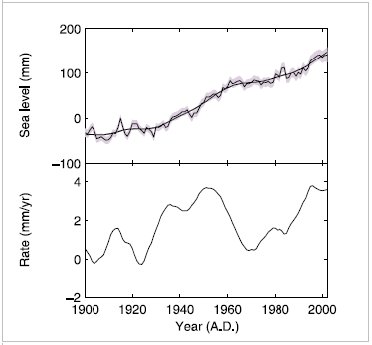A graph of the rate of increase for the 20th century taken from the paper is also at the end of this article. The top part of the graph shows the overall increase of about 0.2 metres during the 20th century, while the bottom part analyses that increase into annual movements. As you can see the rate of increase in sea levels was just as high in the 1950s as now, before falling for several decades and then rising again to its present value. The authors of the paper, which was well noted when it was released, and does not appear to have been seriously contested, point out that this “background acceleration” should add another 0.34 metres to the existing IPCC forecasts of sea height increases for the 21st century. Perhaps. But what is causing this variation and how much of the present increase we can see from the satellite readings is natural and how much is forced in some way? These questions are almost entirely unanswered. The paper’s results were also not a surprise. The authors refer to other research which also points to major variations in sea level increases over decades. The Climate Commission report does not trouble its readers with this information. With these and other curious ommissions it is little wonder that the sceptics paid no attention to it.
However, the media and public in general know very little of any of this. For both them and many scientists, the fact that an undoubtedly large number of scientists in the field say that industrial emissions are causing a part of the climate warmth we can see now, and will increase that warmth in future years, is quite enough. They do not now accord scientists the same adulation that they did before the so called climategate emails incident, where the leading lights of climate science were caught discussing how to hide weaknesses in their case, and how to supress contrary evidence. In my estimation, reporting on climate issues has moved back to something analogous to the reporting on the Millenium Bug before the experts were proved wrong. The mavericks are tolerated rather than despised. Media columnists are more likely to attack the establishment view on greenhouse issues. This is the closest that the greenhouse proponents are now ever likely to get to one voice in the media.
There is another problem. There are indications that the public in general is switching off the issue. American newspapers have recently reported that President Barak Obama has stopped mentioning the environment in his speeches and that consumers are turning away from ‘green’ products, goods sold on the basis of their supposed environmental friendliness. Part of this is due to the fact that media crises have a distinct shelf life. The public will absorb only so much doom and gloom, before looking for the next disaster.
Advertisement
The greenhouse crowd will claim, with considerable justification, that all their tipping points are well into the future, but then there is plenty of evidence that they have over sold their claims. In early 2000, for example, a senior research scientist at the climate research unit at the University of East Anglia, Dr David Viner, declared that within a few years snow “will become a rare and exciting event”. A decade after it was written, the article makes amazing reading. No wonder the climate disaster audience is slipping away.
In Australia, the debate is largely being kept alive by the still warm promise of the Gilliard Labor Government to introduce a carbon tax, and the fact that our economy is in a better position to that of American’s economy. More economic hardship usually means less interest in the environment. However, in Australia a major focus of interest was the seemingly endless series of droughts in the Murray-Darling basin, but those droughts have ended, at least for the moment.
This shift in opinion is being helped along by the carbon tax itself, as consumers finally realise that they are being asked to pay for green activism and do not like the idea one bit. Polls recently reported in both the Australian newspaper and the Sydney Morning Herald indicate that voters are mostly hostile to a carbon tax. This has nothing to do with whether the public actually thinks that industrial activity is responsible for some part of climate change, or that the results will be serious (a recent Griffith University survey shows that many do believe this, although the percentages are lower than they were a few years back). Nor does this apply to the active few who post on On Line Opinion or write letters to newspaper editors. It is the silent majority that is losing interest.
There are those in the global warming camp who refuse to accept this trend at face value, constructing elaborate, even clever explanations involving psychology or sociology. The main problem remains that the various crises have been oversold, the debate has been going on too long, and voters are being asked to pay out. Global warmers will still be able to command a lot of favourable media attention to come, but should enjoy what they can get while they can still get it, rather than complain about the media sometimes daring to quote the other side.
Sea height increase graph from the University of Colorado satellite site. Total increase is on the left. Average annual increase is the straight line.

Advertisement
Graphs from Recent global sea level acceleration started over 200 years ago? by Svetlana Jevrejeva etal. The top graph is total sea level increase over a century. The bottom graph is the increase per year in millimetres. Note that the extreme right of the bottom graph gives a result which is tolerably close to the anual average increase shown in the satellite graph above.

Discuss in our Forums
See what other readers are saying about this article!
Click here to read & post comments.
36 posts so far.